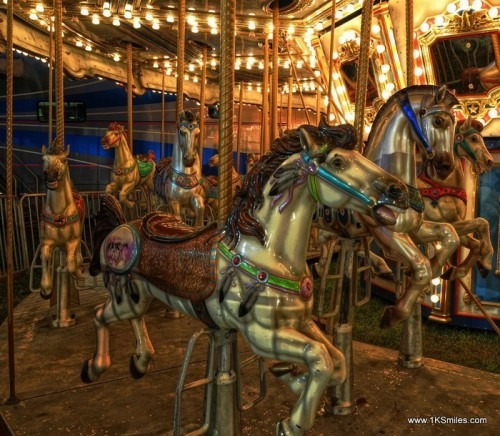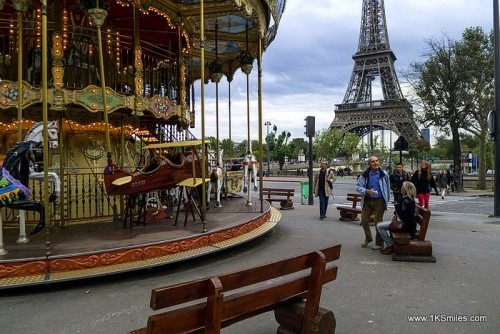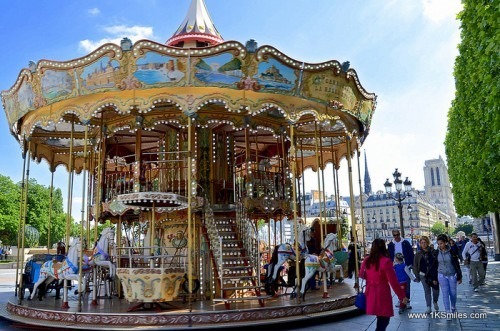The carousel or merry-go-round, is an amusement ride which has a rotating circular platform with seats for the riders. The “seats” are traditionally in rows consisting of wooden horses or other animals which are mounted on posts, many of which move up and down by gearwork to simulate galloping. Although there are usually horses on a merry-go-round often times there are other critters like pigs, zebras, tigers or mythological creatures such as dragons or unicorns. These days they are usually made of fiberglass instead of wood. I have seen bench seats and things like airplanes or cars in place of animals.
In another post I have written about how the mechanical bull was invented as a training device for rodeo competitors. Much the same, the modern merry-go-round emerged from early jousting traditions in Europe and the Middle East. Knights would gallop in a circle while tossing balls to each other; an activity that requires great skill and horsemanship. This game was later introduced to Europe at the time of the Crusades from earlier Byzantine and Arabian traditions. The word carousel originated from the Italian ‘garosello’ and Spanish ‘carosella’ which means “little battle”, and was used by crusaders to describe a combat preparation exercise and game played by Turkish and Arabian horsemen in the 12th century. The Crusaders brought the game back to Europe where it became an extravagant display of horsemanship and finery that the French called carrousel.
A very popular event of the carrousel was the ring-spearing tournament where a man would ride his horse or chariot full speed, lance in hand, toward a small ring hanging from a tree limb or pole by brightly colored ribbons. The objective being to spear the ring.
About 300 years ago, a frenchman had the idea to build a device to train young noblemen in the art of ring-spearing. His device consisted of carved horses and chariots suspended by chains from several arms radiating from a center pole. This early device was essentially a cavalry training mechanism; it prepared the riders for actual combat as they wielded their swords at the mock enemies.
By the 17th century the game was beginning to be played by the commoners and carousels soon sprung up at fairgrounds all over Europe. At the Place du Carrousel in Paris, an early make believe carousel was set up with wooden horses for the children.
Much like the idea of which way water rotates as it goes down a drain in different hemispheres, in Europe, a merry-go-round (as they are most often referred to in those countries) usually turns clockwise while looked on from above, while in North America, carousels typically go counterclockwise (or anti-clockwise as I often like to say just for fun).
One possible reason for carousels in North America turning anti-clockwise may be so that the rider can use their right hand to catch a brass ring. Another possible reason for the reverse direction was in rebellion to the King of England. As well, one typically mounts a real horse by lifting one’s right leg over the animal’s back as it stands with its head toward one’s left (the horse’s left side is called its “near” side). Likewise for a carousel that turns anti-clockwise: one stands on the near side of the horse to mount (toward the center of the carousel, not on its outer edge).
I hear you. I hear you. What about Asia you ask. In Asia, the merry-go-round will usually go clockwise.
According to FindingMickey.com, the idea for a Disney-themed amusement park came to Walt Disney while sitting on a park bench while he watched his daughters ride the Griffith Park Merry-Go-Round. Walt explained, “Well, it came about when my daughters were very young and Saturday was always Daddy’s day with the two daughters. I’d take them to the merry-go-round and as I’d sit there, sat on a bench, you know, eating peanuts, I felt that there should be some kind of an amusement enterprise built where the parents and the children could have fun together. So that’s how Disneyland started.”
The Griffith Park Merry-Go-Round was built in 1926 by the Spillman Engineering Company. Prior to its current location, the carousel was housed at Mission Beach in San Diego, CA as well as the San Diego Expo. It was moved to Griffith Park in 1937. The merry-go-round features 68 horses and 2 chariots while all of the wood-carved horses are jumpers. Music for the carousel is provided by a Stinson 1650 Military Band Organ.
In May 2005, William Henry Dentzel III, built the world’s first solar-powered carousel which operates during Solfest at the Solar Living Institute in Hopland, California.
So there you have it, a brief history and a look to the future of the merry-go-round. Or is it carousel? Which word do you use? Have you ridden a merry-go-round? Where was it? do you prefer the horses or ??? that go up and down or the stationary seats? Click here to leave a comment and share your opinion and experience. Would love to hear from you.
please share it with your friends using the Shareaholic buttons below.
[easyazon_image align=”center” height=”250″ identifier=”B001GGAFTS” locale=”US” nw=”y” src=”https://www.1ksmiles.com/wp-content/uploads/2015/07/51dbZuoEjrL.SL160.jpg” tag=”1ksmiles-20″ width=”250″]
[easyazon_cta align=”center” identifier=”B001GGAFTS” key=”wide-orange” locale=”US” tag=”1ksmiles-20″]



